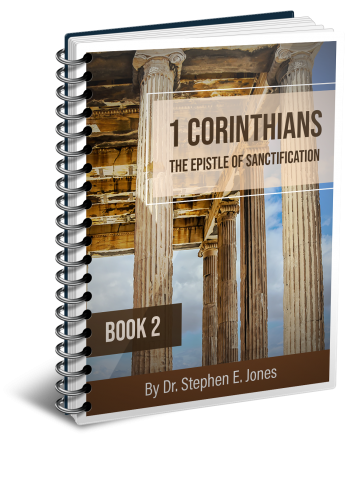Latest Posts
View the latest posts in an easy-to-read list format, with filtering options.

An in-depth commentary/study on chapters 7 through 11 of First Corinthians.
Category - Bible Commentaries

When we first came to Christ, we were spiritually immature. We were children in need of discipline to learn obedience. But children ought to grow up, for the purpose of discipline is to bring them to maturity, so that obedience gives way to agreement.
Obedience is forced unity, or coerced unity. It is both necessary and good for a season, but if it never ends, or if it is designed to be perpetual, then it becomes harmful. The Old Covenant was good for a season, but it was not perfect. Veils can be good for a season, but they do not reflect a perfect relationship. An indirect relationship with God is good for those who are learning through others, such as parents, guardians, pastors, or denominational leaders, but God desires to have a direct relationship with everyone.
Hence, the principle of headship can be applied with two different motives. Headship is authority, and if it is used to perpetuate bondage (slavery), then it is not being applied by the mind of Christ. The ultimate purpose of authority is to set people free, that is, to bring people to the place of maturity where they can be released into the glorious liberty of the children of God.
In 1 Corinthians 11:8-10 Paul says,
8 For man does not originate from woman, but woman from man; 9 for indeed man was not created for the woman’s sake, but the woman for the man’s sake. 10 Therefore the woman ought to have a symbol of authority on her head because of the angels.
The man’s authority is based upon the fact that he was created first. The woman was later taken out of him. It is the same principle by which Christ was given authority in the earth, for He was “the first-born from the dead, so that He Himself might come to have first place in everything” (Col. 1:18). The first-born is given rights and authority that the other children do not have, except when, by legal process, a first-born son becomes disqualified through rebellion. But Jesus was never disqualified, though the Jews presented their case against Him in the divine court (Luke 19:14).
Paul’s assertion of a man’s authority over his wife is based upon the law of the first-born and cannot be rejected without undermining Christ’s own authority over His bride. However, it is equally clear from Galatians 4 that Christ is not interested in marrying another bondwoman. He married a bondwoman under an Old Covenant arrangement, and that marriage failed. Now He seeks a New Covenant bride, for He wants to marry a free woman (Sarah).
For purposes of spiritual symbolism, a woman’s veil signifies submission to her husband, for she recognizes her secondary creation and that she is “the glory of man,” even as the man is “the image and glory of God” (1 Cor. 11:7). This implies that the woman has an indirect relationship with God. Yet this is temporary, because, under the New Covenant, “there is neither male nor female” (Gal. 3:28). In other words, distinctions between male and female no longer exist when the divine plan is complete.
When God took the woman out of the man in a secondary creative act, it not only put Eve under the authority of Adam, but it also made their distinction secondary and temporary. The goal is to reunite them as “one flesh,” while yet retaining their individuality. The phrase “one flesh” is usually thought of as a sexual act, when in fact it is about true unity that is found only when “there is neither male nor female.”
Prior to sin, Adam and Eve enjoyed such unity in their relationship, but after they sinned, God found it good to put Eve under the rule of her husband (Gen. 3:16). History is the path to regain the unity that they enjoyed prior to this divine judgment.
Just as God saw fit to marry a slave woman at Mount Sinai (that is, the nation of Israel), we see also how Israel as a whole did not want a direct relationship with God. When Moses invited them up the Mount, they stayed away, asking Moses to represent them before God (Exodus 20:18-21). Hence, the Old Covenant was characterized by Israel’s indirect relationship with God as a slave-woman.
The invitation itself showed the desire of God, thereby prophesying of a future time when people would lose their fear of God and come under a better covenant.
Again, we see this manifested in the coronation of King Saul on the day of wheat harvest (1 Sam. 12:17). Saul was a type of the church and its lesser kingdom that was ruled by Benjamin, rather than by Judah. His kingdom was doomed to failure, because it was based upon the people’s rejection of God Himself as their King (1 Sam. 8:7). In essence, they wanted an indirect relationship with God, for they wanted an intermediary king. Saul’s kingdom was an Old Covenant church.
If we relate this to marriage itself, it is clear that a master-slave relationship, set forth by veiled women under authority, is not the perfect will of God, nor is it the highest form of marriage. Yet because Saul was a type of the church under Pentecost (i.e., “wheat harvest”), we see historically how the church has perpetuated the Hagar mindset by its denominational systems of submission to men. The Roman church is the greatest representative of King Saul, but it is not alone. Most denominations demand submission to men, and many of them deny that any man or woman can have a relationship with God apart from submitting to their leadership.
Hence, an indirect relationship with God has been set forth as the ideal, and the Old Covenant mindset has hindered most Christians from understanding the New Covenant. The bottom line is that the church has promoted Old Covenant marriage relationships as the ideal, rather than as a temporary accommodation. They see obedience as the highest goal for a woman. They have little understanding of the importance of agreement. If they have any concept of agreement at all, it is to say, “Woman, I demand that you agree with me!” But forced agreement is not God’s desire, nor is it true agreement.
When Israel refused to come into a direct relationship with God at the Mount, God did not refuse to marry the nation. He married her anyway, but the New Covenant and its direct relationship was postponed to a later time. Later, when Israel demanded an earthly king, God did not refuse their request, but gave them instructions on how to make it work—if this were possible. Yet it is clear that Saul’s house would not remain permanently, for his kingdom was not THE KINGDOM that God had in mind.
Paul was a Tabernacles believer in a Pentecostal Age, just as Moses was a Tabernacles believer in a Passover Age. Both had a vision of things greater than what had been established for the general public. Moses came off the Mount with his face glowing under the anointing of the feast of Tabernacles, and yet he was limited by the other Israelites.
Caleb and Joshua, too, were overcomers, and yet they—as individuals—could not enter the Promised Land until the nation was ready.
Paul too was limited by the time in which he lived. The church was Pentecostal. When the 120 disciples went into the upper room to receive the Holy Spirit (Acts 1:13), they did what their forefathers in Israel had refused to do at the Mount. Hence, they were given the Spirit and also the New Covenant itself.
In essence, on the 1480th anniversary of God’s marriage to Israel, the marriage ceremony was repeated in the church. This time it was a New Covenant wedding, but for the church as a whole, its long-term married life degenerated into an Old Covenant relationship. Only the overcomers, believing in the sovereignty of God, had the kind of faith that Abraham did—believing in the promises of God.
Pentecost was good, but it proved to be inadequate, for only Tabernacles has the power to bring in the New Covenant as a permanent fixture. While there are many overcomers who have lived during the Pentecostal Age, they—like Caleb and Joshua—have had to wait until the new nation was ready. Hence, the purpose of the Pentecostal Age has been to prepare a body of overcomers, some from each generation, men and women who, like Moses and Paul, carried a vision of a greater feast and a greater Covenant.
Meanwhile, most believers have reverted to the Old Covenant in their understanding and in their way of life. At the same time, they have followed the same pattern of rebellion found in Israel, for they have rejected the law as evil or irrelevant. Therefore, the law, which reveals His own nature, could not be written on their hearts, as God intended from the beginning.
The early Scriptures, beginning with the law, were written by Moses under the anointing of the Passover Age. To this first body of Scripture, the prophets added commentary and application. Later, under the greater light of Pentecost, the gospels and epistles were written, giving us a clearer understanding of the mind and will of God.
All of these writings are to be considered Scripture, no matter how obscure each passage may be. Over time, pieces of revelation were given to more authors, and by putting these revelations together, we are able to discern greater truth. The problem is that the revelation of Pentecost, though greater than that of the Passover Age, was not a complete revelation. Many things have remained obscure, awaiting further revelation that could make sense of the earlier foundations of truth.
There is hardly any new truth in the New Testament that was not already revealed obscurely in the Old Testament. Yet Christ’s coming provided greater enlightenment and understanding. Likewise, in the Pentecostal Age there have been many doctrinal disputes, because the gospels and epistles have not been clear enough to resolve those disputes. The full truth is there, but it is in fragments, making it difficult to discern without divine intervention through the Holy Spirit’s inspiration.
In my view, Paul (like Moses) suffered from Fragmented Truth Syndrome. When he wrote his earlier epistles, he was still seeking further revelation. He did not learn everything all at once. So his first Corinthian letter was followed by a second. His first discussion about veils was incomplete, and so he enlarged upon it in his second letter to show how veils were connected to the Old Covenant. His second letter did not repudiate what he said in his first letter, but it provided greater understanding and a more balanced perspective.
In the end, I believe that the 66 books of our present Bible, written under the anointing of Passover and Pentecost, will be followed by a final body of writing under the anointing of the feast of Tabernacles. Perhaps we will then receive the hundred-fold revelation of truth with a hundred books of the Bible, so that all denominational disputes will be resolved. Then all denominations and factions, which Paul denounced in the early chapters of his letter, will cease to exist.
The revelation of Tabernacles will then reveal the full understanding of the New Covenant, and all veils that had previously hidden the light of truth, will be discarded.